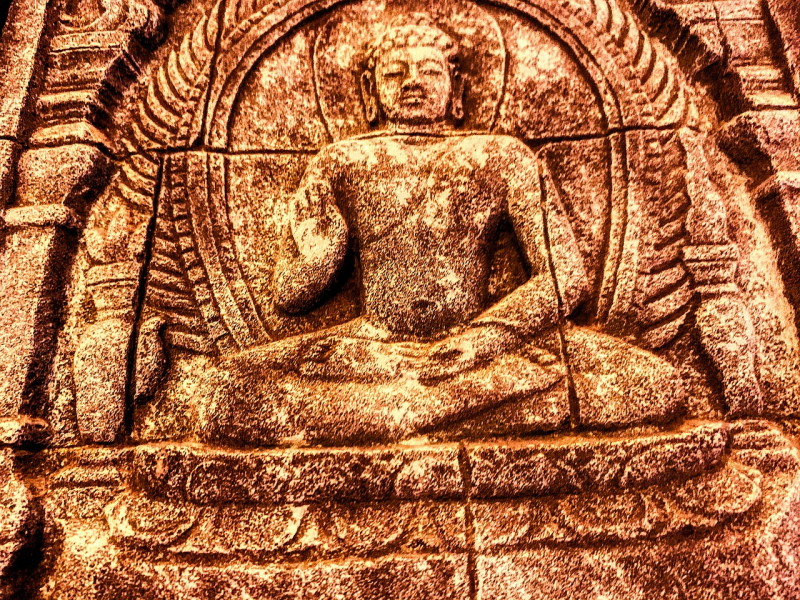Top 9 Levels of Consciousness in Buddhism
Buddhism often describes levels of consciousness and states of mind in its teachings. The concept of the "Nine Buddhist Levels of Consciousness" delves into ... read more...the intricate layers of awareness and perception within the realm of Buddhist philosophy. Let's journey through these levels, uncovering the profound insights they offer on the path to spiritual awakening.
-
Sight-consciousness is foundational in Buddhist philosophy, relating to the intricate dynamics of visual perception. It is a significant facet of consciousness deliberated in diverse Buddhist scriptures and teachings, notably within the 'Twelve Nidanas' and the 'Nine Levels of Consciousness.'
In the context of the 'Twelve Nidanas,' Sight-consciousness is a pivotal link within the chain that elucidates the cyclic journey of suffering and rebirth in Buddhist cosmology. It explains the process wherein the interaction between the eye sense organ and a discernible object gives rise to consciousness. In the 'Nine Levels of Consciousness framework,' sight-consciousness assumes its place as one of the six senses facilitating human engagement with the external world. This consciousness is intrinsically linked to the eye sense organ, manifesting when the eye connects with a visible form.
Sight-consciousness assumes a pivotal role in the landscape of mindfulness meditation practices. Devotees focus on visual sensations and perceptions that emerge while observing external elements or the breath. This deliberate cultivation of awareness around sensory encounters facilitates the maturation of concentration and insight, unraveling the intricacies of the mind's nature and perception.
Buddhism underscores the transient quality inherent in all phenomena, encompassing even Sight-consciousness. Grasping the concept of impermanence becomes pivotal when engaging in insight meditation, a practice that empowers practitioners to capture the fleeting and interconnected essence of existence. Through this profound realization, a heightened comprehension of suffering's nature is attained, further unlocking liberation.

Photo on Wikimedia Commons (https://commons.wikimedia.org/wiki/File:Manbulsa_Nirvana_statue,_or_Reclining_Buddha_11-10238.JPG) Video by Pure Land Buddhism -
Hearing-consciousness represents a distinctive tier among the Nine Buddhist Levels of Consciousness, focusing on the intricate domain of auditory perception. Like other facets of consciousness, hearing-consciousness plays a pivotal role in comprehending the essence of mind, perception, and the journey towards enlightenment.
Embedded in the Nine Consciousnesses structure, Hearing-consciousness emerges as a constituent of the six senses that enable human engagement with the external realm. In a manner akin to sight-consciousness, the encounter of the ear with sound initiates the awakening of consciousness, affording individuals the capacity to decipher and make sense of auditory sensations.
During mindfulness practices, individuals can intentionally focus on the sounds that manifest, whether they originate externally or emanate from internal mental processes. By mindfully tuning into sounds, practitioners can foster a state of presence and nurture a composed, non-reactive, and observant approach to their auditory encounters. This recognition of the transient and dissatisfactory aspects of acoustic experiences, akin to other sensory perceptions, is a valuable tool for practitioners seeking to diminish attachment and cravings.
The integration of Hearing-consciousness into meditation methodologies offers a meaningful avenue for exploration. Certain meditation traditions incorporate sounds as focal points for contemplation, harnessing their potential to enhance concentration and mindfulness. This approach can potentially unveil profound insights into the intricate dynamics of perception, sound, and the nature of the mind.

Photo of https://www.worldhistory.org/Tibetan_Book_of_the_Dead/ Video by Nichiren Buddhism -
Referring to Ghrāna-vijnāna in Sanskrit, Smell-consciousness is a core element of Buddhist philosophy about olfactory perception. It is a facet of consciousness explored within specific Buddhist teachings. It plays a significant role in deepening comprehension of the complexities surrounding the nature of the mind, perception, and the transformative journey toward enlightenment.
Like sight and hearing consciousness, Smell-consciousness constitutes a vital link within the Twelve Nidanas, elucidating the interplay between the nose sense organ and a scent, culminating in the emergence of olfactory perception. This intricate process intertwines with the cycle of suffering and rebirth, a central tenet of Buddhist cosmology.
Within certain meditation traditions, Smell-consciousness is a focal point for meditative contemplation. Devotees may choose to center their attention on the act of smelling itself or the array of sensations triggered by various scents. This dedicated practice nurtures heightened concentration and sensory awareness, yielding profound insights into the essence of smell and the intricate workings of the mind.
Like all sensory encounters, the impermanence inherent in Buddhism applies to Smell-consciousness, forming a foundation for insight meditation. Perceiving the fleeting quality of scents, their emergence and dissolution become a cornerstone of more profound insights into reality and suffering. Mindful awareness of smells aids in minimizing attachment and aversion, fostering a more balanced response to pleasing and unpleasant odors.

Photo on Pixabay (https://pixabay.com/photos/garden-statue-fern-buddha-statue-3398101/) Video by SEEKER TO SEEKER -
Taste-consciousness is a central element in Buddhist philosophy, intricately linked to gustatory perception. It is a facet of consciousness expounded upon in select Buddhist teachings, offering insights into the nature of the mind, perception, and the transformative journey toward enlightenment.
Within the context of the Nine Consciousnesses, Taste-consciousness is pivotal as one of the senses that facilitate human interaction with the world. Like other sensory experiences, taste-consciousness activation occurs when the tongue makes contact with a flavor, giving rise to consciousness and enabling individuals to undergo the diverse sensations and interpretations associated with varying tastes.
Buddhism highlights mindfulness in daily existence, such as during meals. Practitioners mindfully engage in eating, attentively savoring tastes, textures, and sensations linked to food. This fosters heightened sensory presence during meals, reducing attachment and aversion. Mindful taste awareness aids in comprehending the impermanent and unsatisfactory aspects of gustatory experiences, promoting a balanced relationship with flavors and diminishing tendencies for overindulgence or rejection.
Certain meditation traditions integrate Taste-consciousness into their meditation methodologies. Practitioners may focus on the taste experience, utilizing it as a focal point for meditation. This approach nurtures concentration and sensory mindfulness and facilitates insights into the essence of taste and the intricate workings of the mind.

Photo on Pixabay (https://pixabay.com/photos/buddhism-monk-temple-panorama-2214532/) Video by KAILASA's Nithyananda Keerthanalaya -
Touch-consciousness is a pivotal component within Buddhism's Nine Levels of Consciousness framework. It delves into the intricate realm of tactile perception, which is vital for understanding the mind, perception, and the journey toward enlightenment. Touch-consciousness sheds light on how tactile perception shapes our human experience and understanding by assuming a significant role within this framework.
Touch-consciousness explores the intricate relationship between the mind and the body, emphasizing the profound connection between physical sensations and consciousness. These sensations intricately shape our perceptions and reactions to the external world. Within mindfulness practices and meditation, touch-consciousness serves as a valuable focal point. Practitioners concentrate on tactile sensations, including the tactile interaction between the body and different surfaces.
The Buddhist principle of impermanence underpins Touch-consciousness, enabling practitioners to delve into the temporary character of tactile sensations, appreciating their transient and evolving attributes. By comprehending the impermanent and unsatisfactory essence of touch experiences, practitioners forge a harmonious connection with physical sensations, curbing inclinations to cling to pleasurable sensations or react adversely to discomfort.
Within The Nine Levels of Consciousness, delving into touch-consciousness accentuates its role in unveiling the intricate interplay between the mind, body, and the external realm. Like other facets of Buddhist philosophy, the interpretation and importance of Touch-consciousness might differ across various traditions and teachings, collectively enriching a comprehensive grasp of human consciousness and spiritual evolution.

Photo on Pexels (https://www.pexels.com/photo/buddha-statue-near-trees-1344472/) Video by Saint Of Sin -
Mind-consciousness is a central pillar in Buddhist philosophy, delving deep into mental perception and cognition. It distinguishes itself from sensory consciousness by centering on cognitive processes over sensory perceptions, encapsulating thoughts, emotions, and mental constructs. In doing so, it illuminates the intricate mechanics of the mind's inner workings.
Mind-consciousness is crucial in unraveling the intricacies of the mind and its multifaceted functions. It serves as a lens that enables practitioners to keenly observe the emergence and dissolution of thoughts, emotions, and mental states.
Grasping the essence of mind-consciousness is paramount in regulating emotions and attaining spiritual liberation. Through observing the emergence and dissolution of emotions and mental states, practitioners can cultivate equanimity and detachment, paving the path toward ultimate freedom from suffering.
Mind-consciousness further contributes to nurturing virtuous mental qualities like loving-kindness, compassion, and mindfulness. Practitioners can actively engage in purposeful mental cultivation, reshaping their inner mental landscape.
The underlying layers of consciousness profoundly shape the initial six levels. Impulses originating from the seventh and eighth tiers of consciousness influence how the five senses gather information and how the mind processes and comprehends it. Emotions, profound attitudes, and self-attachment can modify or distort our perception. Through the purification of these initial six levels of consciousness, we attain the ability to perceive reality with unclouded clarity. This clarifies the significance of Nichiren's depiction of the "purification of the six sense organs" as a vital gain from Buddhist practice.

Photo on Pixabay (https://pixabay.com/photos/buddha-art-religion-relax-zen-5116777/) Video by TED-Ed -
"Manas," a term employed in select Buddhist traditions, denotes a distinct facet of consciousness referred to as Manas-vijnāna or Manas-consciousness. This specialized form of consciousness is frequently characterized as a mental faculty that functions betwixt sensory consciousness and loftier realms of awareness, bridging the realm of sensory perceptions with deeper layers of consciousness.
Manas-consciousness assumes the role of interpreting and mentally processing sensory data. It receives the unprocessed sensory input from the five senses, infusing it with personal interpretation, biases, and attachments. This nuanced interpretation shapes the genesis of thoughts, emotions, and reactions.
Manas-consciousness assimilates the unfiltered sensory input originating from the five senses and, in the process, incorporates personal interpretations, biases, and attachments. Notably, Manas-consciousness inclines toward fostering attachments, aversions, and distorted perceptions. This propensity can engender the development of self-centered perspectives, reinforcing the concept of an autonomous and enduring self, which diverges from the fundamental tenets of Buddhist teachings concerning the nature of reality.
The essence of Buddhist practice revolves around altering the impact of Manas-consciousness through the nurturing of mindfulness, insight, and wisdom. As practitioners diligently observe and comprehend the mechanics of this facet of consciousness, they incrementally diminish its sway, ultimately attaining a heightened, more lucid perception of reality with reduced distortions.

Photo on Pxfuel (https://www.pxfuel.com/en/free-photo-ercgu) Video by Plum Village -
The eighth tier encompasses alaya-consciousness, denoted by the Sanskrit term "Alaya" meaning "storehouse." This realm serves as the repository of karmic imprints from myriad thoughts, words, and actions across time. How you respond to your friend's anger bears the influence of your cumulative past causes and effects. The initial seven levels of consciousness wane upon death, while the eighth endures ceaselessly, perpetuating the distinctive essence of one's existence throughout the cycles of birth and rebirth.
Alaya-consciousness is considered the fundamental underpinning or bedrock of consciousness within specific Buddhist doctrines. It functions as a reservoir where previous experiences, deeds, and inclinations are etched and conserved, merging into a depository housing karmic imprints accrued over innumerable lifetimes.
Within Alaya-consciousness lie the potential for both constructive and adverse inclinations. These propensities mold our current and future thoughts, emotions, and behaviors. Through the discernment and alteration of these predispositions, practitioners pave the way toward liberation.
The Yogacara tradition systematically classifies Alaya-consciousness into three distinct dimensions: Parikalpita (illusory), Paratantra (interdependent), and Parinispanna (fully perfected). The purification and transformation of Alaya-consciousness become imperative to grasp the genuine essence of reality and achieve emancipation from the relentless cycle of suffering.

Photo on Pxuel (https://www.pxfuel.com/en/free-photo-irchv) Video by Shri Bodhi Dharma 吉祥菩提佛法 -
By delving into an even more profound and potent stratum of consciousness, known as the ninth consciousness or the Amala-consciousness, derived from the Sanskrit term "amala," signifying purity and immaculateness—we can enact a profound metamorphosis of our karma, ultimately engendering paramount value and boundless joy within this very existence.
This ninth consciousness, characterized as the "fundamental pure consciousness," resonates at the profound depths of existence, untainted by any vestiges of karmic impurity. It stands synonymous with the sublime realm of Buddhahood, epitomizing a state of being untarnished by the burdens of karmic encumbrances.
As practitioners delve into the depths of their Amala-consciousness through the profound practice of chanting Nam-myoho-renge-kyo, a remarkable transformation of their karmic inclinations and responses unfolds. This transformative process empowers them to extract value from every facet of existence, even scenarios as seemingly challenging as being subjected to a friend's outburst.
Amala-consciousness is closely tied to the concept of karma and rebirth. It is believed to carry the imprints of past actions and influences the circumstances and experiences of future lives. The cycle of suffering and rebirth continues through Amala-consciousness and karma.

Photo on Needpix (https://www.needpix.com/photo/download/1728820/buddha-lotus-harmony-peace-spiritual-people-culture-design-body) Video by Centre For Amala Consciousness






























